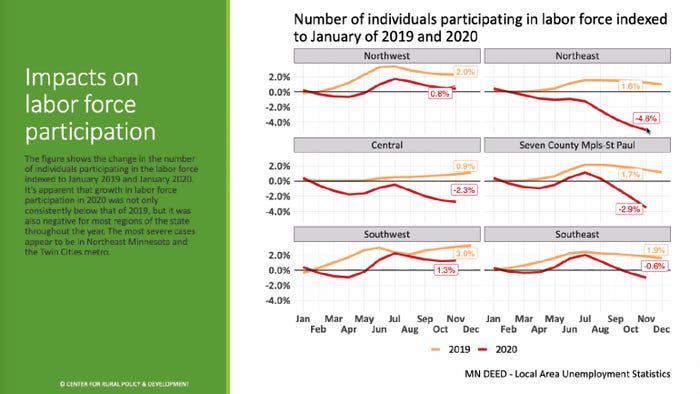
The unemployment picture in rural Minnesota in 2021 presents a dichotomy: Not only is there high unemployment and people dropping out of the labor force, but there also is a workforce shortage.
The pandemic's impact on employment in rural Minnesota is explored in a report, Pandemic Impacts on the Rural Workforce, prepared by the Center for Rural Policy and Development, a nonpartisan policy research organization based in Mankato.
Kelly Asche, a research associate at the center, presented the findings in a Jan. 21 webinar. The question he set out to explore was how the pandemic impacted the supply of workers in Minnesota, what jobs were lost and what jobs remain unfilled.
Jobs related to food preparation and serving, office and administrative support and sales were particularly hard-hit during the pandemic, Asche said. On the other hand, there is a need for healthcare practitioners and technical employees and those who work in life, physical and social science areas.
On the plus side, “we now have a pool of workers to engage,” Asche said.
 WORKFORCE PARTICIPATION: The number of people working in 2020 was lower than in 2019.
WORKFORCE PARTICIPATION: The number of people working in 2020 was lower than in 2019.

The challenge is engaging those potential employees.
“People are dropping out of the labor force and this is a very unique trend ... you just don’t see this very often,” he said.
As a result of the pandemic, some people are choosing to forgo paid employment, instead staying home because their lives have been impacted by COVID-19. Maybe they need to help their children navigate online school, or to care for their children because they no longer have childcare, or because they are fearful of getting the virus. Rural areas also tend to have an older workforce, Asche said, and some of those workers are choosing to stay home out of fear of contracting the virus at work.
For those who are seeking work, there are challenges, too, he said.
The Center for Rural Policy reached out to workforce centers who help the unemployed find work and what they heard fits into four categories:
Workforce development offices in Minnesota are closed or highly restricted, which means there is less one-on-one contact. It's harder to make connections.
As workforce development has shifted online, there are barriers for unemployed people in accessing resources. Some unemployed may lack access to reliable broadband internet and others may not have the technology needed to connect with the workforce center.
Timing is an issue. People are busy now tending their families and are waiting out the pandemic using their unemployment benefits. Workforce development staff anticipate a crush of job-seekers when the benefits expire.
Workforce development organizations get state and federal funding, but they are stretched thin by years of low unemployment. Over the past few years, the workforce development organizations have put emphasis on working with employers to develop training programs. Now, they need to work not only with employers, but also with employees looking for their next job.
Recommendations
The Center for Rural Policy developed four recommendations for legislators considering this issue as the legislative session moves ahead:
Any new programming or funding that the state puts forward should provide local workforce development organizations the flexibility to meet the diverse needs of their region. Each region is unique, Asche said, due to the geographic vastness of Minnesota.
Provide support to local workforce development organizations to help them connect with employers and employees in their communities. They need to work with both groups of customers.
Provide resources for unemployed people to purchase the equipment they need to communicate with workforce development and take advantage of programming offered by workforce development.
Find ways the Department of Employment and Economic Development can better assist in connecting the unemployed with their workforce development programming.
The pandemic has caused a disconnect that is no one's fault, but it is an area to be addressed.
Kubat Willette is a Farm Progress digital content creator.
About the Author(s)
You May Also Like




